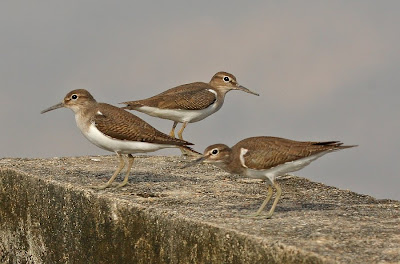

The stint field still held a few Wood Sandpipers.

And the field with Pacific Golden Plovers was still fully occupied.


I came across this Slaty-breasted Rail wandering along the road. I don't think it's a full adult.
With things otherwise quiet at Kampung Pertama, I decided to take the short drive across to the rice-fields on the other side of the highway at Kubang Semang.

There were more birds here as the fields are still being planted and there is more open mud and water. This shot shows a typical paddy-field vista. Wherever there is a man on his 'kobotor' preparing the field for the next planting, there you'll find flocks of egrets, terns and hirundines in attendance. The grey, fortress-like building in the background is a 'swiftlet hotel' - an increasingly commonly-encountered feature of the paddy-field landscape.



Some of the Barn Swallows following the kobotor. The 'gutturalis' race often shows a white throat and brown breastband in juvenile plumage, a feature not often alluded to in the literature available to me, and presenting a possible identification pitfall for the unwary.

A few Intermediate Egrets mingled with the much commoner Little and Cattle Egrets.

This photo shows the proportional differences between Intermediate (front) and Cattle Egrets (back). The two species share the same bare part colours at this time of year.

Little Egrets typically show a pale whitish, pinkish, bluish or occasionally yellowish base to the lower mandible during the non-breeding season.

Another arriving.

The waders were in the quieter fields, and included a small flock of around 30 Curlew Sandpipers - mostly first winters.

The mantle and scapulars, one or two tertials and coverts are fresh non-breeding feathers (which look identical to adult non-breeding). I've shaded these purple, but you can also tell them in the 'undoctored' photo above by their greyer colouration and thin white fringing.
The remaining wing coverts are unmoulted, old juvenile feathers. These have largely faded and bleached so that little of the original juvenile pattern is still visible. Generally, the feathers which are most protected from the elements by the scapulars - typically the marginal and lesser coverts - and some inner median coverts (shaded yellow) are the feathers which remain least worn, so these are the most useful feathers for aging purposes. In the unshaded pic above, you can see that these feathers are darker, browner, and retain the (faded but visible) juvenile pattern.
Incidentally, note how short-billed this bird is. Perhaps it's a male.


Lesser and marginal coverts are usually hidden beneath the scapulars, but are sometimes exposed when the bird preens.

This one hasn't yet moulted its juv scapulars, so is much easier to age. From a distance, this bird will look darker and browner than the more advanced birds.

This bird, by contrast, can only be aged by taking a detailed look. You can just make out some juvenile lesser coverts peeking out beneath the scapulars at the 'top front' edge of the wing. The scapulars on this bird are covering almost all the wing coverts.

On this individual, only a few inner median coverts show the tell-tale dark subterminal 'arrowhead' marks which reveal that this is also a first winter bird.


A first winter Black-winged Stilt. With Stilts, the intensity of the leg and iris-colour is an easy way to age them.

It's not often I get three Common Sandpipers in one shot. Don't ask me how to age them - they're really tough! Moving swiftly on...!

One of a small flock of Grey-headed Lapwings. These were exceedingly wary.

More Grey-headed Lapwings (and a Wood Sandpiper).

A study in simplicity - Wood Sandpiper and water.
No comments:
Post a Comment